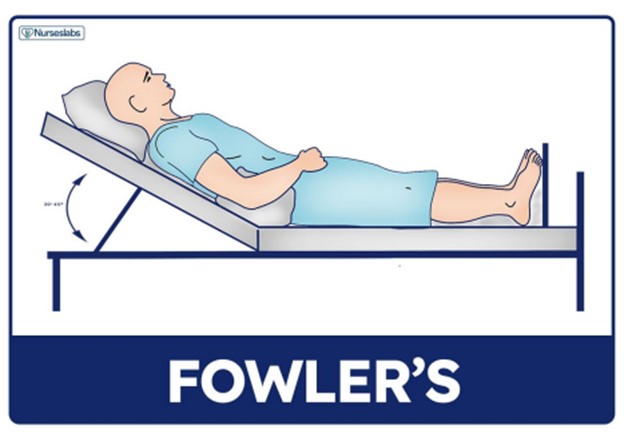A nurse is caring for a client who is 8 hr postoperative following a subtotal thyroidectomy. In which of the following positions should the nurse keep the client?

Semi-Fowler's with neck extended
semi-fowler's with neck in a neutral position
High Fowler's with neck extended
High Fowler's withzed in a neutral position
The Correct Answer is B
A. Semi-Fowler's with neck extended: Keeping the neck extended can put strain on the surgical incision site, increasing the risk of complications. It's important to avoid excessive neck movement.
B. Semi-Fowler's with neck in a neutral position: This position is optimal for clients post-thyroidectomy. It helps reduce swelling and pressure on the surgical site while maintaining the neck in a neutral and supported position.
C. High Fowler's with neck extended: A high Fowler's position with the neck extended may increase the risk of strain on the surgical incision and should be avoided.
D. High Fowler's with the neck in a neutral position: While a high Fowler's position can be comfortable for the client, it's important to ensure that the neck is in a neutral position to minimize strain on the surgical incision.
Nursing Test Bank
Naxlex Comprehensive Predictor Exams
Related Questions
Correct Answer is A
Explanation
A. Serum potassium 2.5 mEq/L and blood pressure 150/90 mmHg - This combination of severe hypokalemia (low potassium) and elevated blood pressure is a concerning finding. It can lead to serious cardiac complications and requires immediate attention.
B. Serum phosphorus 3 mg/dL and hirsutism - While low serum phosphorus may be seen in Cushing syndrome, it is not an immediate concern. Hirsutism (excessive hair growth) is a characteristic feature of Cushing syndrome.
C. Serum calcium 10 mg/dL, and reports of feelings of depression - Although an elevated serum calcium level is not typical in Cushing syndrome, it is not an immediate concern. Reports of depression should be addressed but do not require immediate follow-up.
D. Serum sodium 145 mEq/L and reports of muscle weakness - These findings are not indicative of immediate danger. Elevated serum sodium and muscle weakness can occur in Cushing syndrome, but they do not warrant immediate attention compared to the potassium level and blood pressure in option A.
Correct Answer is ["A","B","D","E"]
Explanation
A. Thyroid stimulating hormone (TSH): The anterior pituitary gland secretes TSH, which regulates the thyroid gland's function. Surgery on the anterior pituitary can potentially disrupt the production and regulation of TSH.
B. Prolactin: The anterior pituitary gland also produces prolactin. Surgery on the anterior pituitary can affect prolactin production.
C. Oxytocin: Oxytocin is produced by the posterior pituitary, not the anterior pituitary. Surgery on the anterior pituitary would not directly impact oxytocin production.
D. Gonadotropin hormones: These include follicle-stimulating hormone (FSH) and luteinizing hormone (LH), which are important for reproductive function. The anteriorpituitary secretes these hormones, so surgery on the anterior pituitary can impact their production.
E. Adrenocorticotropic hormone (ACTH): ACTH is essential for the stimulation of cortisol release from the adrenal glands. The production of ACTH is regulated by the anterior pituitary, so surgery in this area can affect ACTH levels.
Whether you are a student looking to ace your exams or a practicing nurse seeking to enhance your expertise , our nursing education contents will empower you with the confidence and competence to make a difference in the lives of patients and become a respected leader in the healthcare field.
Visit Naxlex, invest in your future and unlock endless possibilities with our unparalleled nursing education contents today
Report Wrong Answer on the Current Question
Do you disagree with the answer? If yes, what is your expected answer? Explain.
Kindly be descriptive with the issue you are facing.
